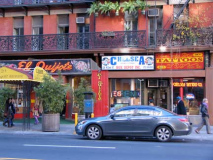The Chelsea and Clinton neighborhoods on the west side of Manhattan are relatively easy to get to from lively Little Neck — the train ride to Manhattan is 22 minutes and Penn Station is smack on the edge of each area, both of which run from 7th Avenue to the Hudson River and (generously) from West 14th to West 57th, with the Lincoln Tunnel approaches the divider between Chelsea and Clinton. (Those who actually live in Clinton much prefer the more colorful Hell’s Kitchen for their neighborhood, but I can’t resist putting the two words Chelsea and Clinton together). Hell’s Kitchen has been covered in FNY before, on ForgottenTour 12 in 2003, but there are nuggets to be dug out in repeat visits, and each neighborhood is picturesque, Chelsea in a quaint, small town enclavish way, Clinton in a big, bruising, gas-fume exhaust way.
WAYFARING MAP: CHELSEA-CLINTON WALK
There are a number of very well-known landmarks on this particular tour that I’m choosing to overlook, since I’m concentrating on Forgotten things, but if you begin a walk at 7th Avenue and West 23rd, it is hard to ignore the Hotel Chelsea, which has been lording it here since 1883 with its magnificent wrought-iron balconies. I am unsure of how or why the Chelsea gained a reputation as a famed writers, ‘ musicians’ and artists’ mecca, but it did so very early on as Mark Twain and O. Henry were early tenants. Dylan, Patti Smith and Warhol’s careers are intertwined with the building as are Allen Ginsberg, Arthur C. Clarke (wrote 2001 here) and Jack Kerouac (wrote On The Road here). Dozens of other household names from the literary, art and music universes have spent time here.
The ground floor of the hotel has always been home to an eclectic variety of businesses. Capitol Fishing Tackle’s bright red and green neon sign was a ficxture till a couple of years ago when it moved to West 35th, complete with neon sign. The El Quixote Restaurant’s neon is still there.
“Chelsea” was the name of Clement Clarke Moore‘s estate (in turn, named for a district in London, England; the name is Old English for “chalk wharf”), now a part of the grounds of the General Theological Seminary campus between 9th and 10th Avenues and West 20th and West 21st Streets. By trade, Moore was a languages professor at King’s College, now long since moved uptown and become Columbia University. He is the supposed author of the Christmas classic poem “The Night Before Christmas” describing the Jolly One’s trip to a housetop and down the chimney. The Moore family also had extensive holdings in Newtown (now Elmhurst) Queens.
“In my part of the country, when you meet an Irishman, you find a first-rate gentleman; but these are worse than savages; they are too mean to swab hell’s kitchen.” —Davy Crockett. The King of the Wild Frontier was referring, in this case, to Five Points, which may have been wilder than Hell’s Kitchen in its day. Somehow the name migrated west. The neighborhood was rife with crime and gang activity in the 19th Century, and the Westies organized crime organization remained active in the neighborhood well into the late 20th. Real estate developers have tried for years to make the Clinton name stick (after DeWitt Clinton Park at 11th Avenue between West 52nd and West 54th) without success.

The Chelsea Hotel’s brother building at 208 West 23rd is the Carteret Building, an apartment rental building constructed in 1926.


Across the street is the Muhlenberg Branch of the NYPL, built with funds donated by steel icon and philanthropist Andrew Carnegie in 1906, and named for pastor William Augustus Muhlenberg of the Chelsea Church of the Holy Communion, who donated many books to the Circulating Library, later the NYPL.
The Don
Scenes from West 20th and West 21st Street between 8th and 9th Avenues.

The bell and clock tower of St. Peter’s Episcopal Church, 346 West 20th Street, overlooks the entire block. The church was organized in 1831, with the present rectory built the following year, and the existing church building in 1838 — making it one of Chelsea’s oldest outside the grounds of the General Theological Seminary.
West 21st Street (and east 21st) was here, in a matter of speaking, before the rest of the street grid came to the area from 1826-1828, as it was a colonial-era road stretching nearly river to river called Abingdon Road or Love Lane. From FNY’s Jackson and Abingdon Square page:
Most of Greenwich Village, in the pre-Revolutionary War era, belonged to British Vice-Admiral Sir Peter Warren, whose oldest daughter, Charlotte, wed Willoughby Bertie, the Fourth Earl of Abingdon; her dowry included the patch of land now called Abingdon Square. It retained its name, despite NYC’s systematic excision of street and place names evincing British royalty in the post-Revolutionary era, since the Earl had sided with the patriots.

Chelsea Court, corner of 9th and West 21st, features huge window lintels and pair of handsome gate lampposts.

352-354 West 21st--I have always been attratced to casement windows.

The Donac, 402 West 20th, has an unusual name that is anagrammatic: it was built in 1898 in honor of developer Don Alonzo Cushman, who built many of Chelsea’s row houses (see below). According to the New York Times’ architecture expert Christopher Gray, Cushman was a bookkeeper who amassed a fortune in the dry goods business. Cushman’s time in Chelsea was remembered by his granddaugher Pauline Sainsbury in her book, ”Cushman Chronicles — a Tale of Old Chelsea,” in 1932.

Cushman Row, 406-418 West 20th opposite the General Theological Seminary, between 9th and 10th Avenues, a Greek Revival row developed by Don Alonzo Cushman in the 1860s.

The key to the impressive quality of this row is the ten foot depth of the front yards. This setback enabled the designer to producea monumental effect for the doorway and stoop on buildings only twenty-one feet wide. Careful attention to detail adds further to the overall quality of the design. Nos. 408 and 414 are in perfect condition, except for the loss of their cast iron candelabrum-type newel posts which once stood on the stone pedestals. These, an amalgam of Greek motifs crowned.with pineapples, remain at Nos. 416 and 418. The other changes in the row are so few as to constitute a miracle in ever-changing New York.
The attic windows, set in a wide fascia board ornamented with dentils and bead and reel moldings, are encircled with laurel wreaths of cast iron and give an impression of height to the building. The six-ovar-six windows, the molded lintels and the well proportioned entablatures carried on Doric pilasters over the doors, are all typical of the -best to be found in the Greek Revival style. The transom above the doors and the one-paneled doors are also trimmed with egg and dart and bead and reel moldings.
The wrought iron handrailings of the stoops are of an unusually rich design, often seen in Chelsea. The yard railings have a Greek fret pattern at the base, palmettoes as crestings and panels of lyre-shaped pattern, flanking the gateway’s, a design which was also used at the northeast corner of Washington Square. Chelsea Landmarks Preservation Commission Report

Church of the Guardian Angel, 193 10th Avenue at West 21st Street, once again across from the General Theological Seminary. The parish originated on West 23rd Street in 1888. The original church had to be torn down in the early 1930s to make way for the West Side Elevated Freight Railroad — today known as High Line Park. The New York Central Railroad, therefore, funded this new Sicilian Romanesque church that was completed in 1930. Lavish bas reliefs on the 10th Avenue side depict the life of Christ.

Boarded-up and abandoned diners are always a sad sight. I never actually got inside the Empire, at 10th Avenue and West 22nd Street, since by the time I was aware of it, the cuisine — and the prices — had become somewhat too haute for your webmaster. (The lost Cheyenne Diner, at 9th Avenue and West 33rd, with its selection of burger specials, was a home away from home).

The Empire was created by the Fodero Dining Car Company in 1946 and renovated into a cuisine restaurant in 1979. A stainless steel model of the Empire State Building was installed on the corner that vanished after the Empire closed in May 2010. Rumor has it the Empire will reopen under new management, but of course, with an expensive menu.


Examples of New Architecture have sprung up along High Line Park ever since, it seems, plans became finalized to turn the old freight line into a high concept trailway. At left isHL23 at 515 West 23rd, a residential tower completed by architect Neil Denari in 2010. Hard to tell from this angle but the tower bows out on the top 4 floors to stretch over the High Line. Author Sebastian Jünger’s Half King Restaurant is on the near side of the elevated, while the Kempner Gallery is on the corner of 10th Avenue; the West 20s from 10th to the river are home to a number of fine art galleries.
245 10th Avenue Apartments, 2009 Della Valle Bernheimer, looks like one of those shiny reflectors people use at the beach to get a good face tan.


And now, back to the 10th Avenue we’ve always known and loved. Joe’s Tavern, at 10th and West 25th, hasn’t served a drink for several years but its classic neon sign is still in place.

Across the street, the auto glass and repair center has added a Dali-esque touch.
[many of these auto shops have ben forced to move out as rents rise in the area of the High Line]

Multifamily architecture, 1920 (foreground) and 2010 (background) from 10th Avenue and West 29th. The high rise in the background is 316 11th Avenue at West 30th which, according to The Real Deal, is emblematic of a ‘pioneering spirit.’

At West 30th, an arm of High Line West Side railroad arches over 10th Avenue, magnificent in its simplicity and form-following-function. It formerly too freight trains east to the Morgan mail processing plant still in operation on 9th Avenue. The Hudson River Railroad also formerly had a terminal here, and the nation’s 16th President-Elect stopped here in 1861 on the way to his inauguration in Washington, DC:
Lincoln’s train reached New York and the Hudson River Railroad’s depot at 30th Street and Tenth Avenue at three p.m. His waiting carriage–an open barouche that had transported the visiting Prince of Wales only a few months before–was escorted to the Astor House, opposite City Hall Park, by a mounted platoon of the newly formed Metropolitan Police.
New Yorkers, largely Democratic in their sentiments, had cast 62 percent of their votes for candidates other than Lincoln, but streets and buildings were crowded with spectators. Across from the Astor House, Barnum’s Museum, at the corner of Chatham Street (now called Park Row) and Broadway, was decked out in bright welcoming banners and flags. Postscripts
30th Street is expected to be the northern end of High Line Park (for at least the next few years, as ownership rights to the section north to 34th street are worked out). The section overlooking 10th Avenue is expected to be aprime viewing platform.

Underneath the trestle lurk some of NYC’s only working incandescent-bulb Westinghouse “cuplight” AK-10s. I hope these are retained after the High Line restorations, but they’ll probably be replaced by higher-intensity lights.


Jumping north to West 36th and 10th you find a building that architecture critics have said was ahead of its time, anticipating the streamlined International Style with its large windows when it was constructed in 1914, the Hill Publishing Company Lofts. The building itself is now an architect mecca with offices of Gwathmey Siegel and Richard Meier. Art gallery Exit Art is housed on the ground floor.

The Lincoln Tunnel entrance/exit plaza at West 39th affords several Midtown vistas at 10th Avenue. In this one, the tall tower in the center is The Orion, a residential tower at 350 West 42nd Street. At 58 stories tall, it dwarfs the adjacent erstwhile “green giant,” the Coke bottle green McGraw Hill Building, which is seen to its immediate right. You can snag a 3 bedroom apartment at the Orion for 2 and a quarter million, give or take a few cents. If I had that kind of money, I’d buy a farm upstate in the fresh air. Raymond Hood designed both the McGraw Hill Building, which opened in 1931, the same year as the Empire State Building.

This view features the new 52 story New York Times Building (Renzo Piano, architect) on the left. The Times Building opened in November 2007. Annie Liebowitz, famed for her portraits in Rolling Stone Magazine, did a sequential series of photographs while the building was under construction. Forest City Ratner Companies was the developer, having acquired several buildings on the east side of 8th Avenue between West 40th and 41st Streets by eminent domain, as several building owners did not wish to sell, a situation echoic of the Forest City Ratner modus operandi in the vicinity of the Atlantic Yards project in Brooklyn (as of 2011, the project had been reduced to the Barclays Arena and the adjacent parking). The original Times Tower still stands at 7th Avenue, West 42nd, and Broadway, though it is home to just advertisements and ‘the zipper’ news runner.
The King of All Buildings peeks above other area skyscrapers. The ESB’s size and scale is better appreciated from just across the East River in Brooklyn and Queens, where it better dominates the skyscape.

Looking northwest from West 39th, you can see the new Silver Towers (2009, Costas Kondylis), which top both The Orion and the Times Building, both at 60 stories in height. The buildings feature a private 75-foot long swimming pool and a public park. These aren’t to be confused with the 1960s Silver Towers residential buildings in the NYU/Washington Square University Village area.

Nikola Tavelic Croatian Center on West 40th Street just west of 10th Avenue. Croatia is a country in southeastern Europe bordered by Slovenia, Hungary, Bosnia and Herzogovina, Serbia, and Montenegro, with the capital city of Zagreb. It declared independence from Yugoslavia in 1991. Hrvatska is the name of the country in the Croatian language.
St. Raphael’s was constructed around 1910 (the cornerstone is worn and indistinct) on West 41st west of 10th Avenue and in 1977 combined with Sts. Cyril and Methodius Church as the Croatian Church. Cyril and Methodius were Greeks born in the province of Thessalonia in the 9th Century Byzantine era. as a part of their mission to bring Christianity to eastern Europe, they devised the Glagolitic alphabet to compose manuscripts and translate them into Slavonic. Its descendant alphabet, Cyrillic, is of course used in Russian script and in other eastern European languages.
WAYFARING MAP: CHELSEA-CLINTON WALK
Turning east on West 44th from 10th, here’s a quiet row of side street houses. The beauty of Clinton-Hell’s Kitchen is that it’s minutes away from the Crossroads of the World, and yet, it’s fairly quiet on the side streets yet bustling on 7th 8th and 9th Avenues. Right: at #432 West 44th is the former 7th Associate Presbyterian Church (1859) now the Actor’s Studio, a membership organization for actors, screenwriters and directors, founded in 1947 by Elia Kazan, Cheryl Crawford, and Robert Lewis. The name most prominently associated with the Studio is Lee Strasberg, who taught acting here from 1951-1982. Some of the biggest names in show business have been associated with Actor’s Studio over the decades.

Yet another repurposed church a few doors down now used in the stage profession is at 424 West 44th, a Gothic Revival church is now home to the New Dramatists; “dedicated to the playwright” is the inscription over the door.
Founded in 1949 by a playwright, Michaela O’Harra, New Dramatists is a unique resource for the American theatre. The company is dedicated to the playwright and serves as an artistic home, research and development center, and national writers colony. The company finds and nurtures new talent through a competitive membership selection process and a seven-year playwright development program tailored to the writers’ individual needs.
New Dramatists gives writers the tools that they need — time, generous theatre space, a pool of talented and experienced actors and directors, writing equipment, meeting space, and a gifted peer community — to grow artistically and strengthen their commitment to theatre. The company augments this central focus on artistic growth through programs that advocate and distribute each writer’s work to theatre producers, through grants and fellowships, and with annual playwriting retreats in Lake Placid, New York and Key West, Florida. Playscripts
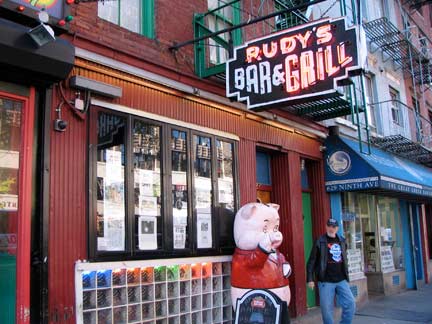

Rudy’s Bar and Grill (and it does have a grill — you get a free hot dog with a beer) has been a mainstay on 9th Avenue between West 44th and 45th Streets since the 1930s.
Crowned by antique Tiffany lamps, the booths are all covered in duct tape. The house beers– a red and a terrific blonde — run you $2.50 for a pint and $7 for a pitcher….there’s little space among the young bankers and advertising types who long ago elbowed out the boozy neighborhoodies who used to dominate [I think they wound up in Smith’s on 8th Avenue — your webmaster]. Nowadays old timers who wander in seem out of place, especially after sundown whe the post-work crowd settles in. I witnessed a septuagenarian trying to get the atention of another septuagenarian. Though they were standing only five feet away from each other, it was too loud for them to hear one another. –Ben Westhoff, New York City’s Best Dive Bars, 2nd Edition, IG Publishing 2010

Meanwhile, a blue neon sign to counterpoint Rudy’s red one can be found at the Film Center Cafe, a few doors away. The reviews are all over the place, from 1 star to 5 — you have to get there on a good day, I suppose.

Turning west again on West 46th. The miniature Gothic St. Clement’s Episcopal Church (423 West 46th between 9th and 10th) was constructed as a Presbyterian church in 1870 by architect Edward Lindsey. The Episcopal parish was founded in 1830, just after the east-west streets were laid out. Befitting its Theatre Distict locale, the church is also home to two stages. St. Clement, an early First Century pope, is symblized by the “mariners’ cross’ since according to tradition, he was martyred under the Roman Emperor Trajan when an anchor was fastened to his neck and he was thrown oveboard from a ship.
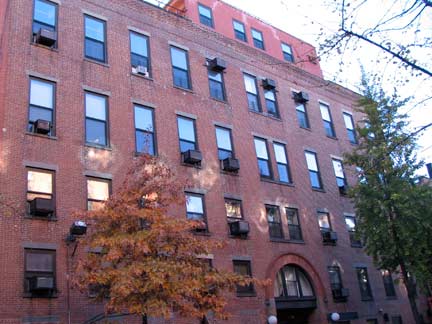
Besides its theatre associations, Hell’s Kitchen was also home to several piano factories. This one at 452-458 West 46th was constructed in 1888 and converted to residences in 1980.

Salvation Army warehouse, originally belonging to the Ackar, Merrall and Condit warehouse at 536 West 46th between 10th and 11th Avenues.

Though smoked meat is among my chief pleasures in life (my standards are modest) I have not yet had the chance to sample Daisy May’s BBQ USA at 11th and West 46th.


I have been in the venerable Landmark Tavern (626 11th Avenue at West 46th) just once, and it was so long ago that my memories have sufficiently faded, though no doubt I enjoyed the experience. The tavern has been here since 1868, making it among NYC’s oldest saloons, putting it in the same league as McSorley’s on East 7th in the East Village and the Ear Inn on Spring Street., though it hasn’t gotten nearly as much buzz. The nearby Intrepid Sea, Air and Space Museum, a block away on 12th Avenue, no doubt gives the Landmark good business (as it does for Daisy May’s).
The Landmark originally was located near the water’s edge and served the workers of railroads, slaughterhouses, stables, stockhouses and factories of the West Side of the 1860s. As with many of NYC’s older saloons it was a speakeasy during the Prohibition era.

11th Avenue, which I had thought was mostly lined with used car dealerships (which is mostly true) will surprise you here and there. I was attracted to this sign for McGlynn, Hayes & Co., elevator repair service, as the West 47th Street block between 11th and 12th Avenues is a “600” block, yet the sign says “62.”

Meanwhile, the lamp dealer City Knickerbocker is on the second floor at West 48th. McGlynn, Hays has been in business since 1900, City Knickerbocker since 1906, when it began by serving the Metropolitan Opera, expanded to stage shows of all types, and finally general retail.


The SW corner of 11th Avenue and West 49th Street is pretty nondescript, and it’s hard to think of this parking lot corner ever being “descript,” but it was formerly occupied by the classic Munson Diner, one of three diners along 11th Avenue along with the demolished River Diner (11th and West 37th, used in the classic 1985 Scorsese picture After Hours) and the recently revived Market Diner.
The Munson was disassembled in 2005 and moved to upstate Liberty, NY, but by early 2011 it had gone out of business once again.

10th and West 49th classic NYC apartment building on northeast corner.

The narrow sidewalks along West 49th illustrate the original folly of not placing service alleys mid-block, behind the apartment buildings. In Manhattan, garbage has to be placed on the curbline, blocking the sidewalk and creating an aroma in season.

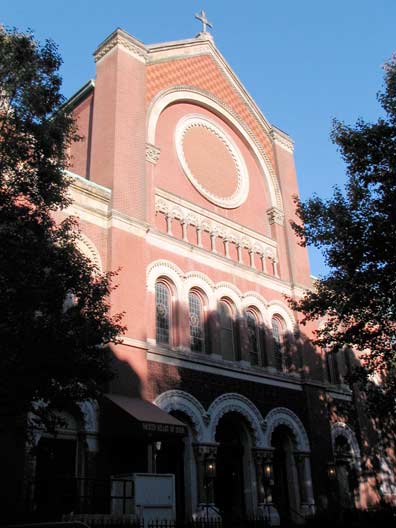
Sacred Heart of Jesus Church, 457 West 51st, just east of 10th Avenue. The Victorian Romanesque church and its associated rectory go back to 1881-1884.

The Elsw Building, 10th Avenue and West 53rd, was the Elsworth Building before it was sliced in half by the construction of the Archstone Clinton Apartments in 2008.

454 West 57th, Hydra Place, east of 10th Avenue. Not sure what they were getting at here, as the Hydra was a 9-headed dragon or sea serpent destroyed by Hercules as one of his 12 Labors in classic myth.
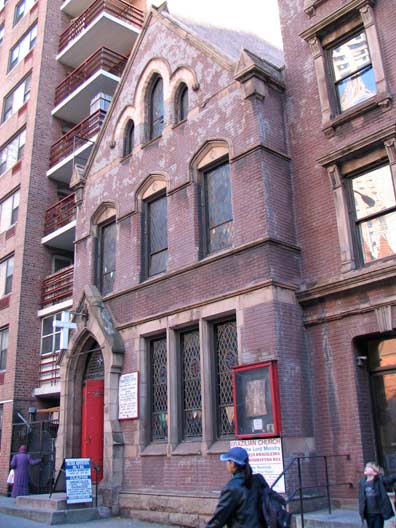

I was fascinated by this tiny church at 422 West 57th. According to David Dunlap’s indispensable From Abyssinian to Zion: a Guide to Manhattan’s Houses of Worship, this was the Mizpah Chapel of the Central Presbyterian Church when constructed in 1886; Trinity Presbyterian, the current occupant, organized in 1947.

At 9th and West 57th, a humungous apartment building dwarfs a minuscule “taxpayer” on the corner.

On the SW corner is the classic apartment building The Windermere. This page began with the shabby-chic 1883 Chelsea Hotel on West 23rd, and The Windermere, which was built in 1881 (Theophilus G. Smith) is actually older, since it was built in 1881. In recent decades it sunk from shabby chic to just plain shabby; by the 2000s it had become an SRO.
The Windermere is an early apartment building which marketed flats to “The New Woman” in 1881 — single, working women, living alone…
The Windermere has endured two decades of virtually no maintenance, at the hands of an absentee owner, a foreign corporation. A professional engineer retained by the Conservancy found the building to be in precarious condition in June 2005. It is not safe for occupancy. Much of the roof and floor framing has extensive water damage. The structural stability of the unbraced brick masonry parapets, cornices and decorative features is also an active concern. Several non-profit and private real estate developers have expressed interest in renovating and restoring the facility. However, the owner has not been cooperative or communicative. NY Landmarks Conservancy

Finally at Columbus Circle is the new/old Museum of Arts and Design, constructed in 1965 by architect Edward Durrell Stone. It was widely derided in its original incarnation as the “Lollipop Building” (so called because of lollipop-shaped ornamentation on the ground floor). It was reconstructed with a new facade in 2008.

Across the street, the twin-towered Time Warner Center replaced the equally-derided New York Coliseum in 2003. In the lobby, the gift shop ‘Mxyplyzyk’ misspells the name of a Superman arch-enemy, the impish Mr. Mxyzptlk. Of course you need to know how to spell his name because pronouncing his name backward correctly is the only way to get rid of him.
Photographed October 2010; page completed April 12, 2011
Your webmaster Kevin Walsh: kevin@forgotten-ny.com
©2011 FNY




